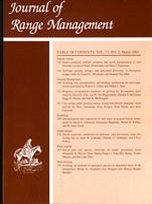Individual animal selection has been proposed as a tool for increasing uniformity of grazing on rugged rangeland. Daily grazing patterns of cows previously identified as preferring steeper slopes and higher elevations (hill climbers) were compared to cows preferring gentler slopes and lower elevations (bottom dwellers). Cows were ranked for slope use and vertical distance traveled to water during late summer in 1997 using horseback observers. In 1998, 9 extreme cows based on 1997 rankings (4 hill climbers and 5 bottom dwellers) were tracked using Global Positioning System (GPS) collars for 3 weeks during late summer on foothill rangeland. Hill climbers (1027 hours) arrived at water about 1 hour later (P = 0.04) than bottom dwellers (0928 hours). Hill climbers and bottom dwellers left water at the same time (1801 hours, P = 0.3). During this interval, 90% and 98% of the observations were within 100 and 200 m of water, respectively. While cattle were away from water (1901 to 0846 hours), 56%, 77%, and 87% of the observations were within 200, 300, and 400 m, respectively, from the cow's location at 0700 hours. Hill climbers spent 14% of their time on steeper slopes (20 to 30 degrees) while bottom dwellers spent 7% (P = 0.01), and hill climbers (41%) tended (P = 0.07) to spend less time on gentler slopes (0 to 10 degrees) than bottom dwellers (47%). Hill climbers (1323 m) were observed at higher elevations (P = 0.01) than bottom dwellers (1277 m). Horizontal distance traveled to water (633 m) was similar (P > 0.1) for hill climbers and bottom dwellers. Cow location during the early morning (0700 hours) was a good predictor of terrain used during the morning and previous evening grazing bouts. Cows tracked in this study did not appear to regularly associate with each other. They usually grazed in different areas of the pasture and regularly used different water sources. Individual cows within a herd can use different terrain even though many aspects of the grazing patterns are similar. Location of cows during the early morning and perhaps the time that cows travel to water can be used to identify differences in terrain use among individual animals.
How to translate text using browser tools
1 January 2004
Research observation: Daily movement patterns of hill climbing and bottom dwelling cows
DEREK W. BAILEY,
MARTINA R. KEIL,
LARRY R. RITTENHOUSE
ACCESS THE FULL ARTICLE

Journal of Range Management
Vol. 57 • No. 1
January 2004
Vol. 57 • No. 1
January 2004
cattle
distribution
global positioning system
grazing behavior




